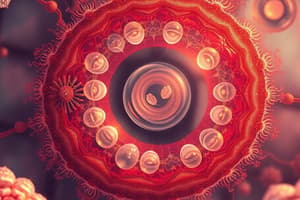Podcast
Questions and Answers
What is a eukaryotic cell?
What is a eukaryotic cell?
A type of cell that has a membrane-enclosed nucleus and other membrane-enclosed organelles.
What is the endomembrane system?
What is the endomembrane system?
A series of internal membranes and membrane-enclosed organelles that are largely interconnected.
What is endosymbiosis?
What is endosymbiosis?
A symbiotic relationship in which one species resides within another species.
What is a protist?
What is a protist?
What is a protozoan?
What is a protozoan?
Where are protozoans commonly found?
Where are protozoans commonly found?
What is an amoeba?
What is an amoeba?
What are slime molds?
What are slime molds?
What are algae?
What are algae?
What are seaweeds?
What are seaweeds?
What is a colony in biology?
What is a colony in biology?
What describes the cells of colonies?
What describes the cells of colonies?
What describes the cells of multicellular organisms?
What describes the cells of multicellular organisms?
Which of the following organisms are classified within the protists under algae? (Select all that apply)
Which of the following organisms are classified within the protists under algae? (Select all that apply)
How long did it take in the history of life on Earth to go from the first prokaryotic cells to the first eukaryotic cells?
How long did it take in the history of life on Earth to go from the first prokaryotic cells to the first eukaryotic cells?
How did mitochondria and chloroplasts arise in eukaryotic cells?
How did mitochondria and chloroplasts arise in eukaryotic cells?
Why is it hard to classify protists?
Why is it hard to classify protists?
What are the steps toward multicellularity, in the correct order?
What are the steps toward multicellularity, in the correct order?
An organism is considered truly multicellular when ________.
An organism is considered truly multicellular when ________.
Approximately when did the earth's crust solidify?
Approximately when did the earth's crust solidify?
Which began first, multicellular life in the ocean or land plants?
Which began first, multicellular life in the ocean or land plants?
When did the first eukaryotic cells form?
When did the first eukaryotic cells form?
Which was first on the planet, prokaryotes or eukaryotes?
Which was first on the planet, prokaryotes or eukaryotes?
Based on the endosymbiosis theory, how would you expect chloroplasts to divide when a plant cell divides?
Based on the endosymbiosis theory, how would you expect chloroplasts to divide when a plant cell divides?
By what means do amoebas and slime molds move?
By what means do amoebas and slime molds move?
Flashcards are hidden until you start studying
Study Notes
Eukaryotic Cells and Related Concepts
- Eukaryotic cells feature a membrane-enclosed nucleus and organelles.
- The endomembrane system comprises interconnected internal membranes and organelles in eukaryotic cells.
- Endosymbiosis describes a symbiotic relationship where one organism lives within another.
Protists and Their Diversity
- Protists are eukaryotic organisms that do not fall under the categories of plants, animals, or fungi.
- Protozoans are heterotrophic protists that primarily ingest food, resembling animal behavior.
- Protozoans thrive in aquatic and moist environments.
Types of Protists
- Amoebas are flexible protozoans characterized by pseudopodia for movement and feeding.
- Slime molds are a unique category of protists with amoeboid characteristics.
- Algae are photosynthetic protists that convert sunlight into food, producing oxygen as a byproduct.
- Seaweeds are large, multicellular algae that inhabit rocky shorelines and shallow marine waters.
Colonies vs. Multicellularity
- Colonies consist of genetically identical prokaryotic or protist members living closely, with cells capable of independent survival.
- Multicellular organisms are formed by specialized cells that cannot survive alone, contrasting with colony cells.
Evolutionary Milestones
- Organisms within protists include algae such as seaweeds, diatoms, and dinoflagellates.
- The transition from prokaryotic to eukaryotic cells spanned over a billion years.
- Mitochondria and chloroplasts in eukaryotic cells originated from independent prokaryotic organisms through endosymbiosis.
- Challenges in classifying protists arise from their varied complexity, nutritional methods, and diverse forms.
Steps to Multicellularity
- The progression to multicellularity starts with protist colonies, followed by cell specialization, culminating in the formation of gametes.
- True multicellularity occurs when the cells within an organism cannot survive independently.
Timeline of Life on Earth
- The Earth's crust solidified approximately 4 billion years ago.
- The first eukaryotic cells emerged around 2.1 billion years ago, following the earlier existence of prokaryotic cells.
Cell Division and Movement
- Chloroplasts are expected to divide through binary fission, mirroring bacterial division methods.
- Amoebas and slime molds utilize pseudopodia for locomotion.
Studying That Suits You
Use AI to generate personalized quizzes and flashcards to suit your learning preferences.




